ICT Project Management - Desklib
VerifiedAdded on 2023/06/12
|18
|3396
|309
AI Summary
This article covers the MOV, Scope and Scope Management Plan, Activity Scheduling, Project Risk Analysis and Plan, Quality Management Plan, Closure Checklist, Evaluation Plan, and Annotated bibliography for ICT Project Management. It includes a detailed breakdown of each section, along with tables and figures to help readers understand the concepts better.
Contribute Materials
Your contribution can guide someone’s learning journey. Share your
documents today.
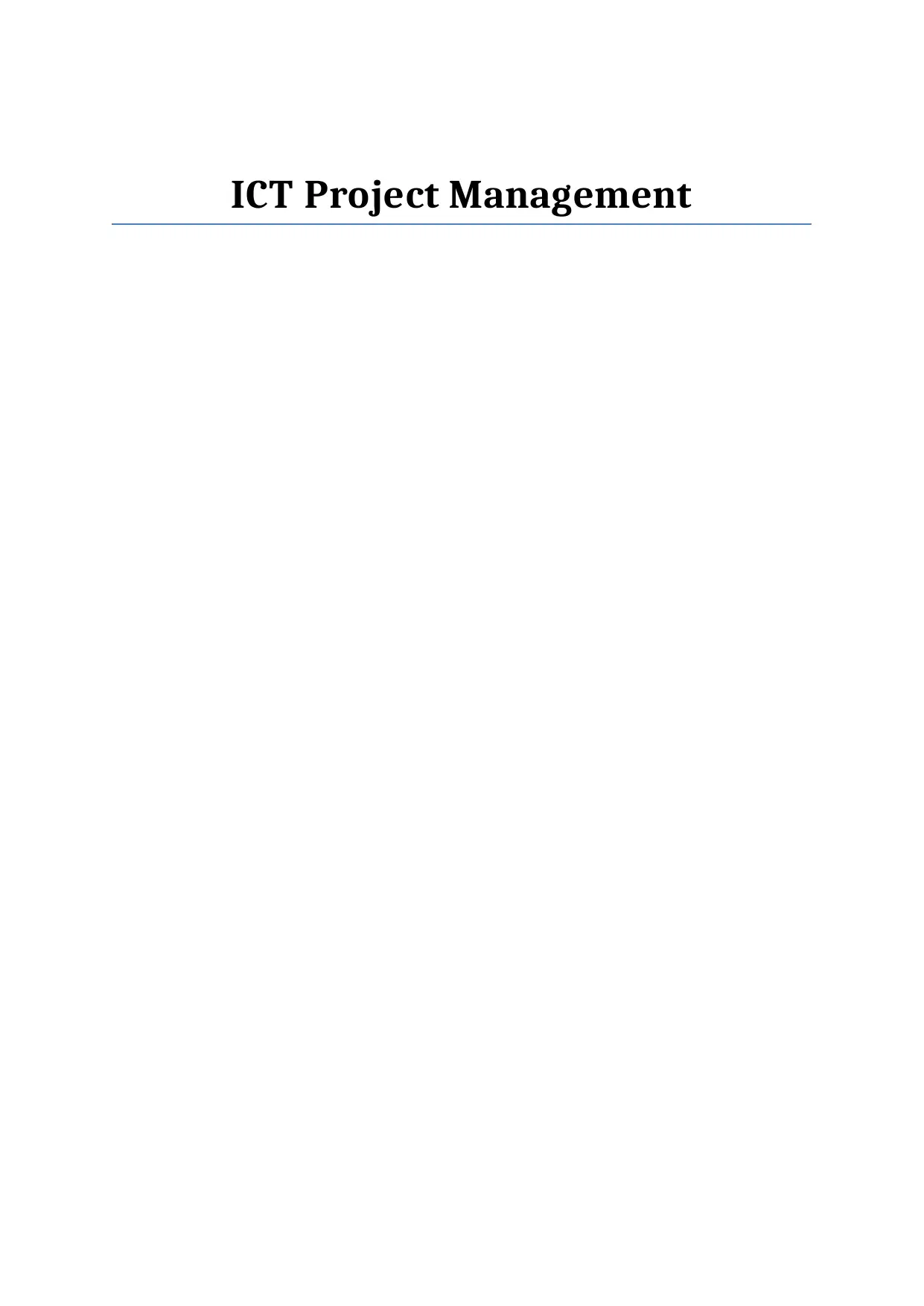
ICT Project Management
Secure Best Marks with AI Grader
Need help grading? Try our AI Grader for instant feedback on your assignments.
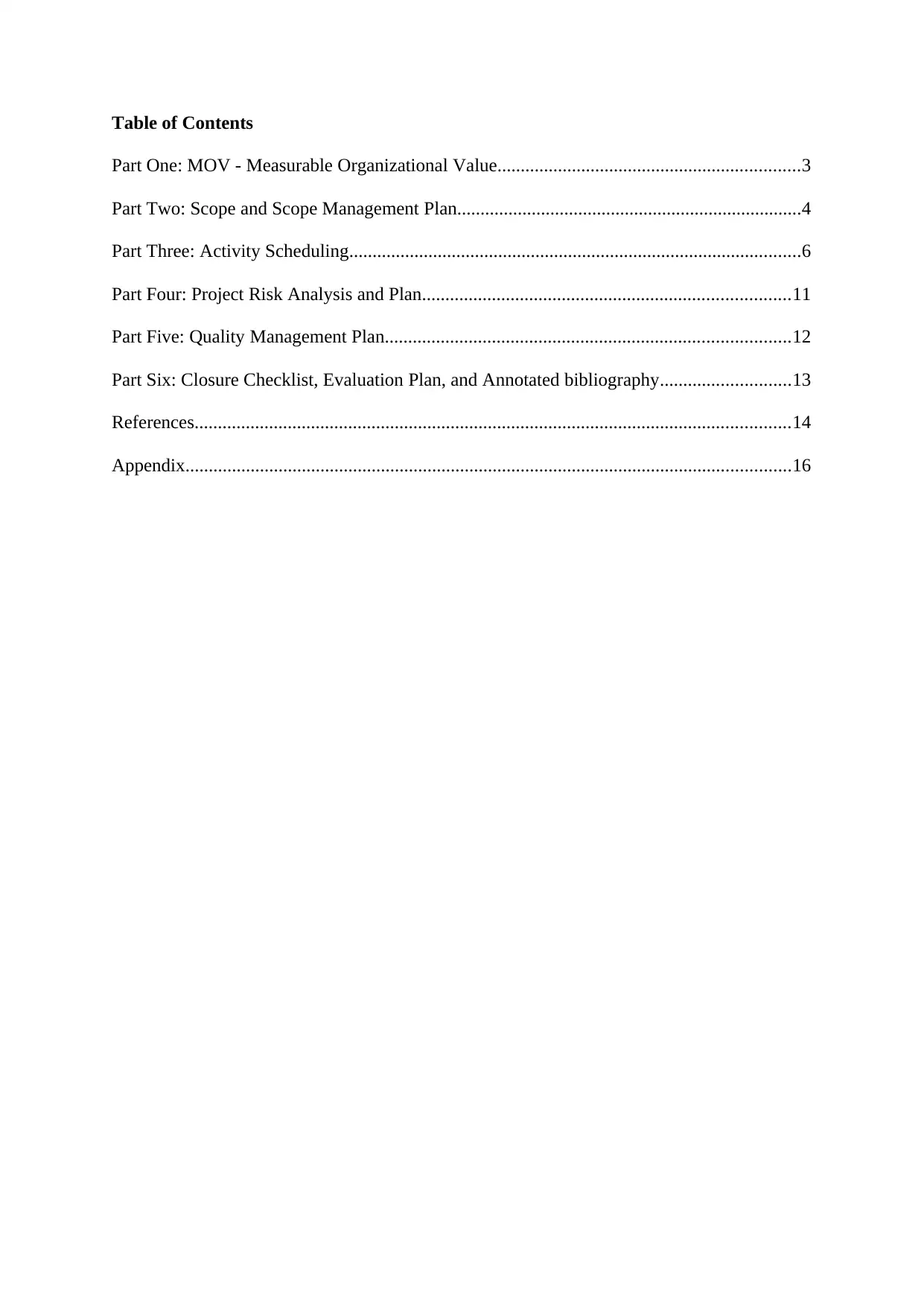
Table of Contents
Part One: MOV - Measurable Organizational Value.................................................................3
Part Two: Scope and Scope Management Plan..........................................................................4
Part Three: Activity Scheduling.................................................................................................6
Part Four: Project Risk Analysis and Plan...............................................................................11
Part Five: Quality Management Plan.......................................................................................12
Part Six: Closure Checklist, Evaluation Plan, and Annotated bibliography............................13
References................................................................................................................................14
Appendix..................................................................................................................................16
Part One: MOV - Measurable Organizational Value.................................................................3
Part Two: Scope and Scope Management Plan..........................................................................4
Part Three: Activity Scheduling.................................................................................................6
Part Four: Project Risk Analysis and Plan...............................................................................11
Part Five: Quality Management Plan.......................................................................................12
Part Six: Closure Checklist, Evaluation Plan, and Annotated bibliography............................13
References................................................................................................................................14
Appendix..................................................................................................................................16
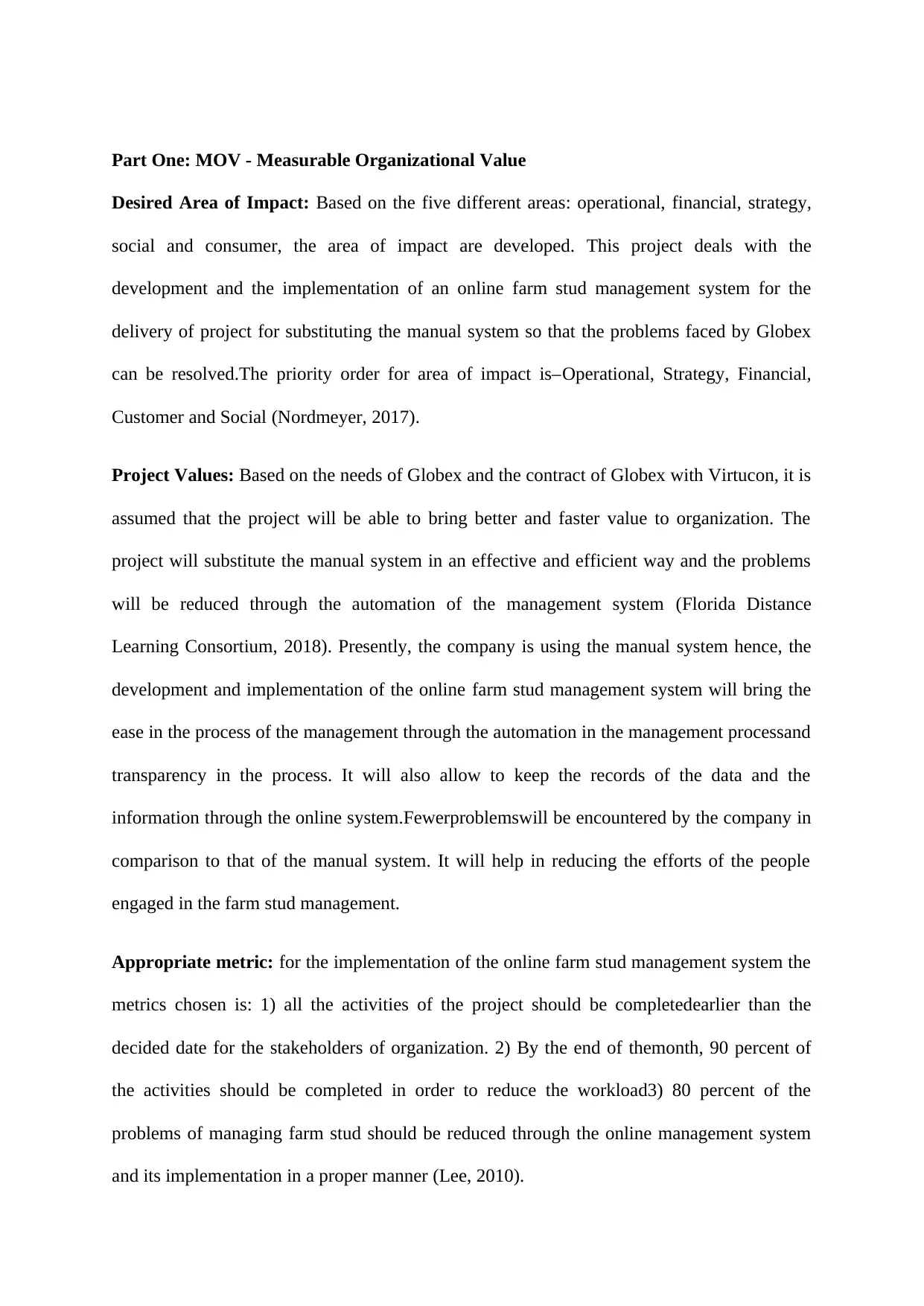
Part One: MOV - Measurable Organizational Value
Desired Area of Impact: Based on the five different areas: operational, financial, strategy,
social and consumer, the area of impact are developed. This project deals with the
development and the implementation of an online farm stud management system for the
delivery of project for substituting the manual system so that the problems faced by Globex
can be resolved.The priority order for area of impact is–Operational, Strategy, Financial,
Customer and Social (Nordmeyer, 2017).
Project Values: Based on the needs of Globex and the contract of Globex with Virtucon, it is
assumed that the project will be able to bring better and faster value to organization. The
project will substitute the manual system in an effective and efficient way and the problems
will be reduced through the automation of the management system (Florida Distance
Learning Consortium, 2018). Presently, the company is using the manual system hence, the
development and implementation of the online farm stud management system will bring the
ease in the process of the management through the automation in the management processand
transparency in the process. It will also allow to keep the records of the data and the
information through the online system.Fewerproblemswill be encountered by the company in
comparison to that of the manual system. It will help in reducing the efforts of the people
engaged in the farm stud management.
Appropriate metric: for the implementation of the online farm stud management system the
metrics chosen is: 1) all the activities of the project should be completedearlier than the
decided date for the stakeholders of organization. 2) By the end of themonth, 90 percent of
the activities should be completed in order to reduce the workload3) 80 percent of the
problems of managing farm stud should be reduced through the online management system
and its implementation in a proper manner (Lee, 2010).
Desired Area of Impact: Based on the five different areas: operational, financial, strategy,
social and consumer, the area of impact are developed. This project deals with the
development and the implementation of an online farm stud management system for the
delivery of project for substituting the manual system so that the problems faced by Globex
can be resolved.The priority order for area of impact is–Operational, Strategy, Financial,
Customer and Social (Nordmeyer, 2017).
Project Values: Based on the needs of Globex and the contract of Globex with Virtucon, it is
assumed that the project will be able to bring better and faster value to organization. The
project will substitute the manual system in an effective and efficient way and the problems
will be reduced through the automation of the management system (Florida Distance
Learning Consortium, 2018). Presently, the company is using the manual system hence, the
development and implementation of the online farm stud management system will bring the
ease in the process of the management through the automation in the management processand
transparency in the process. It will also allow to keep the records of the data and the
information through the online system.Fewerproblemswill be encountered by the company in
comparison to that of the manual system. It will help in reducing the efforts of the people
engaged in the farm stud management.
Appropriate metric: for the implementation of the online farm stud management system the
metrics chosen is: 1) all the activities of the project should be completedearlier than the
decided date for the stakeholders of organization. 2) By the end of themonth, 90 percent of
the activities should be completed in order to reduce the workload3) 80 percent of the
problems of managing farm stud should be reduced through the online management system
and its implementation in a proper manner (Lee, 2010).
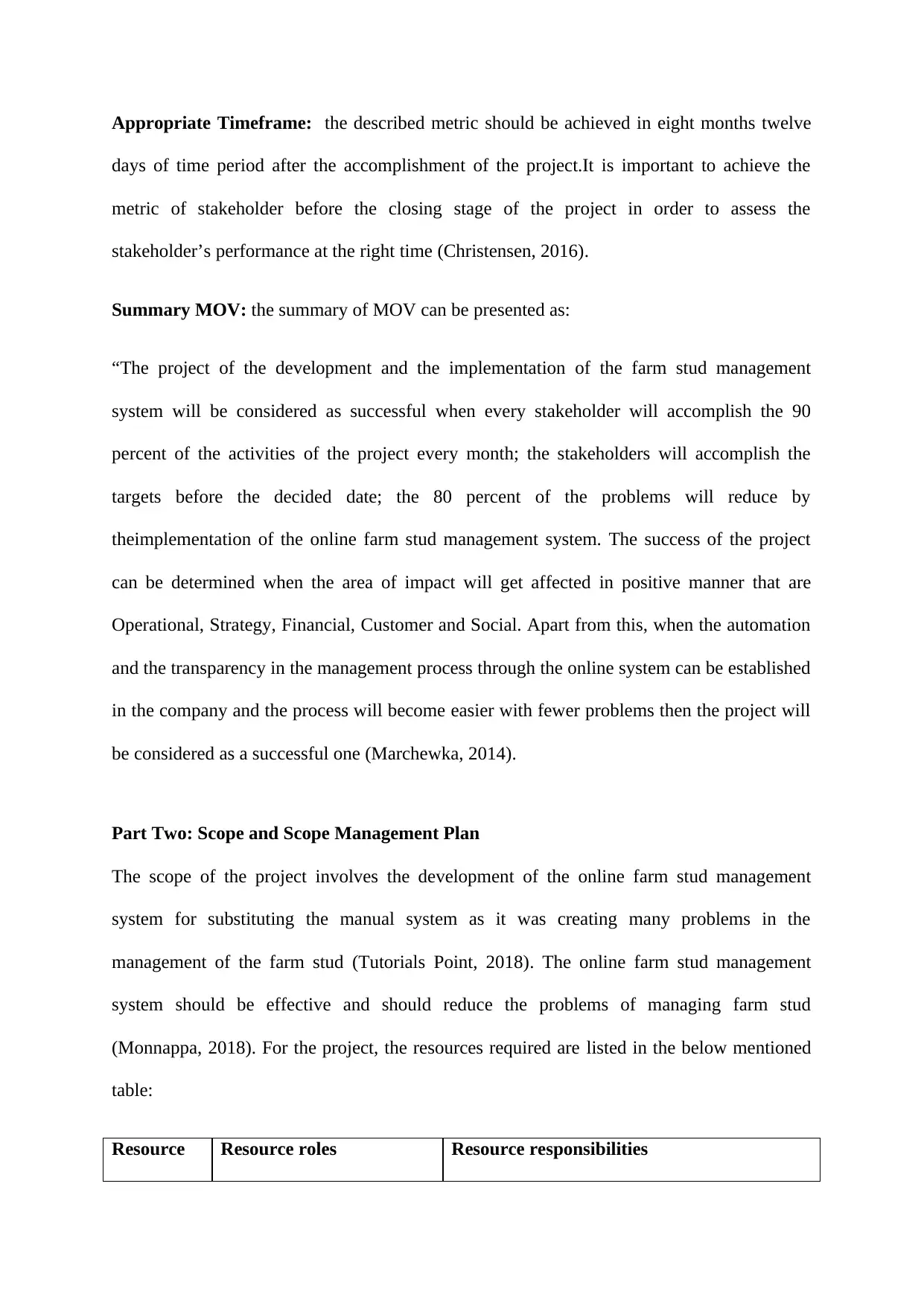
Appropriate Timeframe: the described metric should be achieved in eight months twelve
days of time period after the accomplishment of the project.It is important to achieve the
metric of stakeholder before the closing stage of the project in order to assess the
stakeholder’s performance at the right time (Christensen, 2016).
Summary MOV: the summary of MOV can be presented as:
“The project of the development and the implementation of the farm stud management
system will be considered as successful when every stakeholder will accomplish the 90
percent of the activities of the project every month; the stakeholders will accomplish the
targets before the decided date; the 80 percent of the problems will reduce by
theimplementation of the online farm stud management system. The success of the project
can be determined when the area of impact will get affected in positive manner that are
Operational, Strategy, Financial, Customer and Social. Apart from this, when the automation
and the transparency in the management process through the online system can be established
in the company and the process will become easier with fewer problems then the project will
be considered as a successful one (Marchewka, 2014).
Part Two: Scope and Scope Management Plan
The scope of the project involves the development of the online farm stud management
system for substituting the manual system as it was creating many problems in the
management of the farm stud (Tutorials Point, 2018). The online farm stud management
system should be effective and should reduce the problems of managing farm stud
(Monnappa, 2018). For the project, the resources required are listed in the below mentioned
table:
Resource Resource roles Resource responsibilities
days of time period after the accomplishment of the project.It is important to achieve the
metric of stakeholder before the closing stage of the project in order to assess the
stakeholder’s performance at the right time (Christensen, 2016).
Summary MOV: the summary of MOV can be presented as:
“The project of the development and the implementation of the farm stud management
system will be considered as successful when every stakeholder will accomplish the 90
percent of the activities of the project every month; the stakeholders will accomplish the
targets before the decided date; the 80 percent of the problems will reduce by
theimplementation of the online farm stud management system. The success of the project
can be determined when the area of impact will get affected in positive manner that are
Operational, Strategy, Financial, Customer and Social. Apart from this, when the automation
and the transparency in the management process through the online system can be established
in the company and the process will become easier with fewer problems then the project will
be considered as a successful one (Marchewka, 2014).
Part Two: Scope and Scope Management Plan
The scope of the project involves the development of the online farm stud management
system for substituting the manual system as it was creating many problems in the
management of the farm stud (Tutorials Point, 2018). The online farm stud management
system should be effective and should reduce the problems of managing farm stud
(Monnappa, 2018). For the project, the resources required are listed in the below mentioned
table:
Resource Resource roles Resource responsibilities
Secure Best Marks with AI Grader
Need help grading? Try our AI Grader for instant feedback on your assignments.
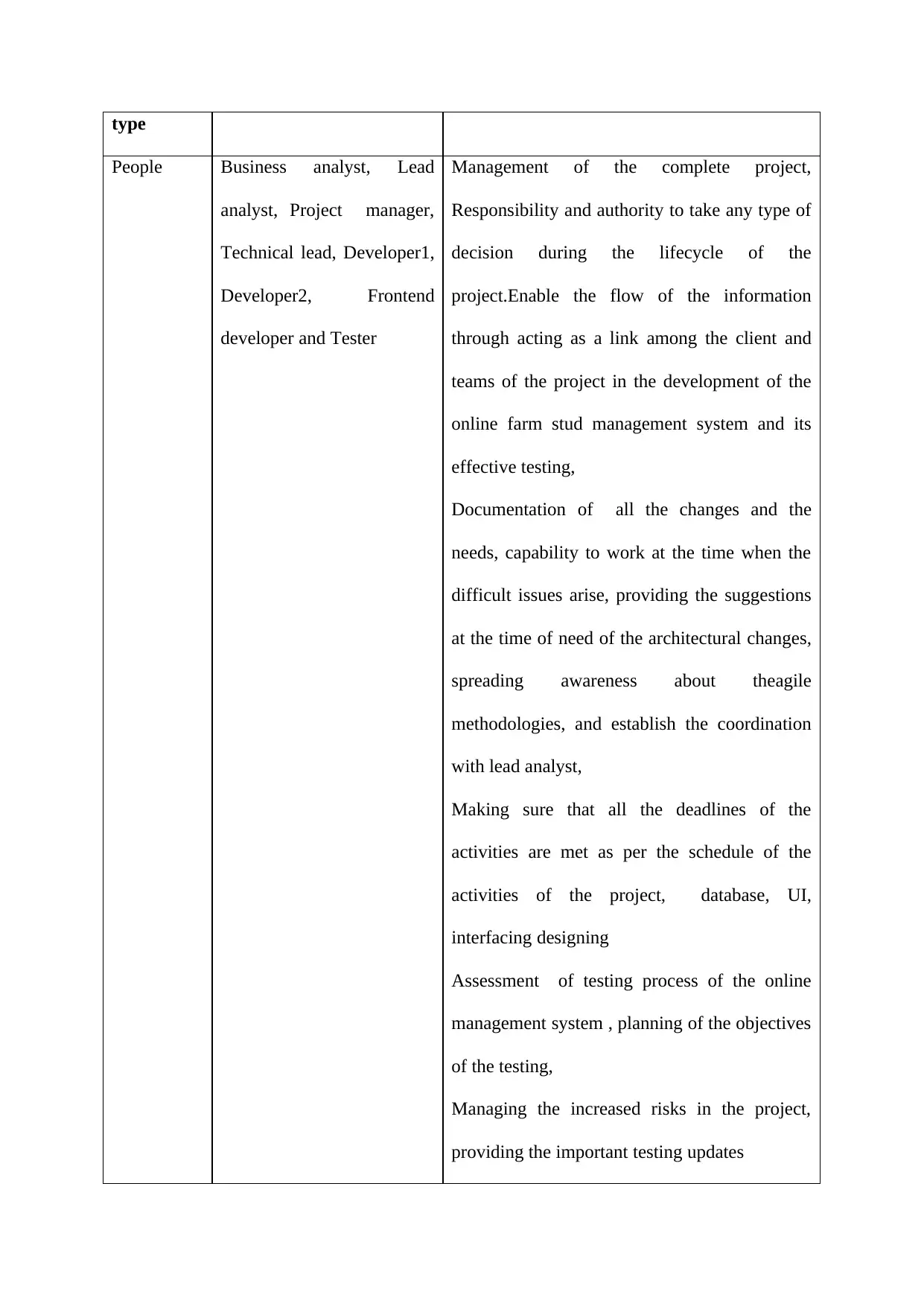
type
People Business analyst, Lead
analyst, Project manager,
Technical lead, Developer1,
Developer2, Frontend
developer and Tester
Management of the complete project,
Responsibility and authority to take any type of
decision during the lifecycle of the
project.Enable the flow of the information
through acting as a link among the client and
teams of the project in the development of the
online farm stud management system and its
effective testing,
Documentation of all the changes and the
needs, capability to work at the time when the
difficult issues arise, providing the suggestions
at the time of need of the architectural changes,
spreading awareness about theagile
methodologies, and establish the coordination
with lead analyst,
Making sure that all the deadlines of the
activities are met as per the schedule of the
activities of the project, database, UI,
interfacing designing
Assessment of testing process of the online
management system , planning of the objectives
of the testing,
Managing the increased risks in the project,
providing the important testing updates
People Business analyst, Lead
analyst, Project manager,
Technical lead, Developer1,
Developer2, Frontend
developer and Tester
Management of the complete project,
Responsibility and authority to take any type of
decision during the lifecycle of the
project.Enable the flow of the information
through acting as a link among the client and
teams of the project in the development of the
online farm stud management system and its
effective testing,
Documentation of all the changes and the
needs, capability to work at the time when the
difficult issues arise, providing the suggestions
at the time of need of the architectural changes,
spreading awareness about theagile
methodologies, and establish the coordination
with lead analyst,
Making sure that all the deadlines of the
activities are met as per the schedule of the
activities of the project, database, UI,
interfacing designing
Assessment of testing process of the online
management system , planning of the objectives
of the testing,
Managing the increased risks in the project,
providing the important testing updates

Technology Java 8 OCp, CXA and UX;
HTML5, Angular JS3,
CSS3, and Act JS
The technologies are needed for development of
the online farm stud management system.
Facilities Department of Development
and deployment
Provides key development tools and
infrastructure needed for the designing and the
implementation of the online farm stud
management system.
Others Team members
Training
Appropriatecoordination and communication,
Providing the proper training needed for
additional resources.
Part Three: Activity Scheduling
The schedule of the activities of the project is created by the help of MS project software
using Gantt chart (Persons, Davidson, & Tompkins, 2018).The table of schedule is presented
so that all the activities can be allocated in a proper manner with the defined period of time
by the available resources. The estimation of the time and the sequence of theactivitiesof the
project are developed with the help of the Gantt chant. It also helped in establishing the link
between the various activities of the project. Apart from this, the work breakdown structure is
also developed using the developed Gantt chart in order to understand the activities and the
hierarchy of the activities in an effective manner in the diagrammatical manner.
HTML5, Angular JS3,
CSS3, and Act JS
The technologies are needed for development of
the online farm stud management system.
Facilities Department of Development
and deployment
Provides key development tools and
infrastructure needed for the designing and the
implementation of the online farm stud
management system.
Others Team members
Training
Appropriatecoordination and communication,
Providing the proper training needed for
additional resources.
Part Three: Activity Scheduling
The schedule of the activities of the project is created by the help of MS project software
using Gantt chart (Persons, Davidson, & Tompkins, 2018).The table of schedule is presented
so that all the activities can be allocated in a proper manner with the defined period of time
by the available resources. The estimation of the time and the sequence of theactivitiesof the
project are developed with the help of the Gantt chant. It also helped in establishing the link
between the various activities of the project. Apart from this, the work breakdown structure is
also developed using the developed Gantt chart in order to understand the activities and the
hierarchy of the activities in an effective manner in the diagrammatical manner.
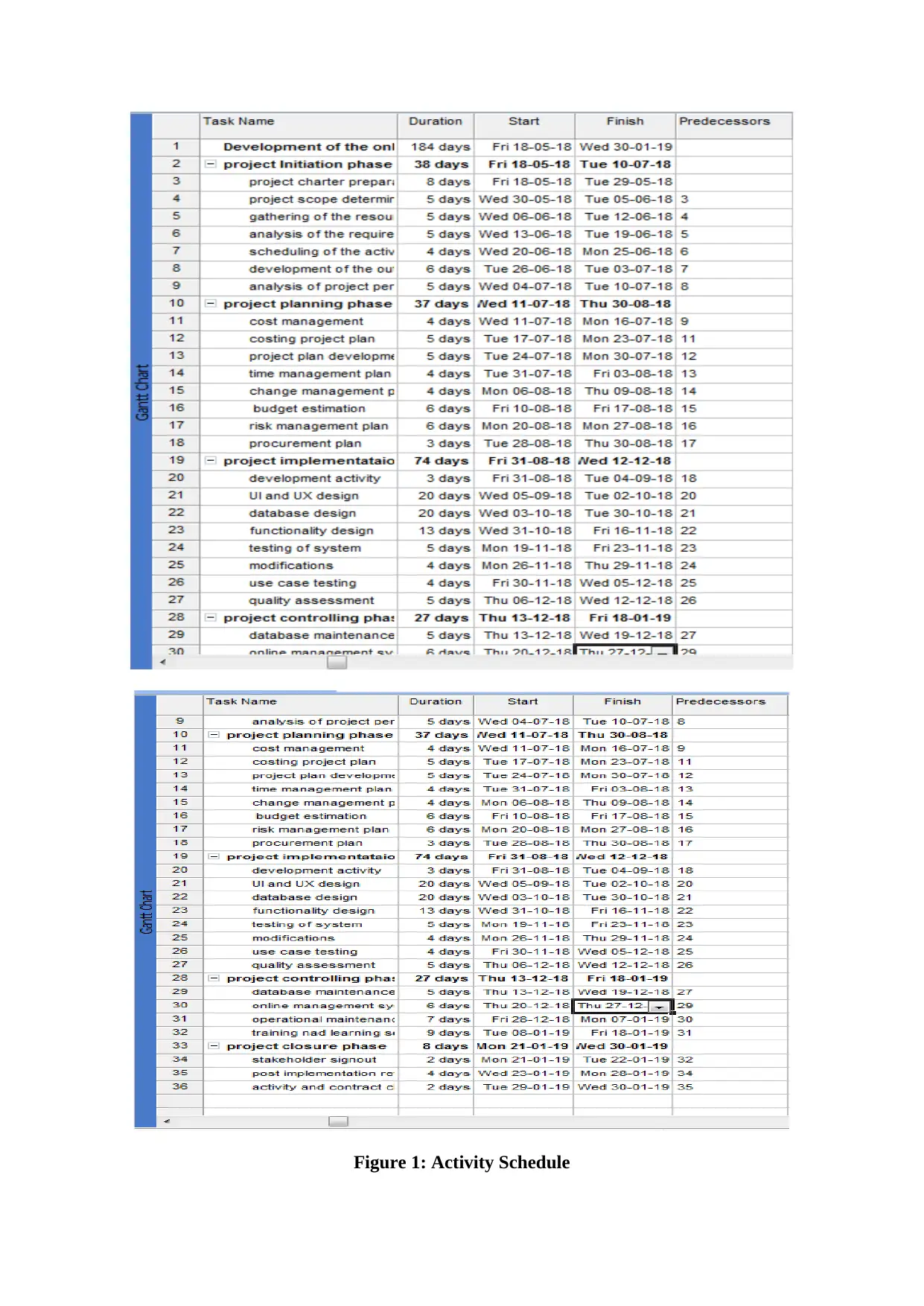
Figure 1: Activity Schedule
Paraphrase This Document
Need a fresh take? Get an instant paraphrase of this document with our AI Paraphraser
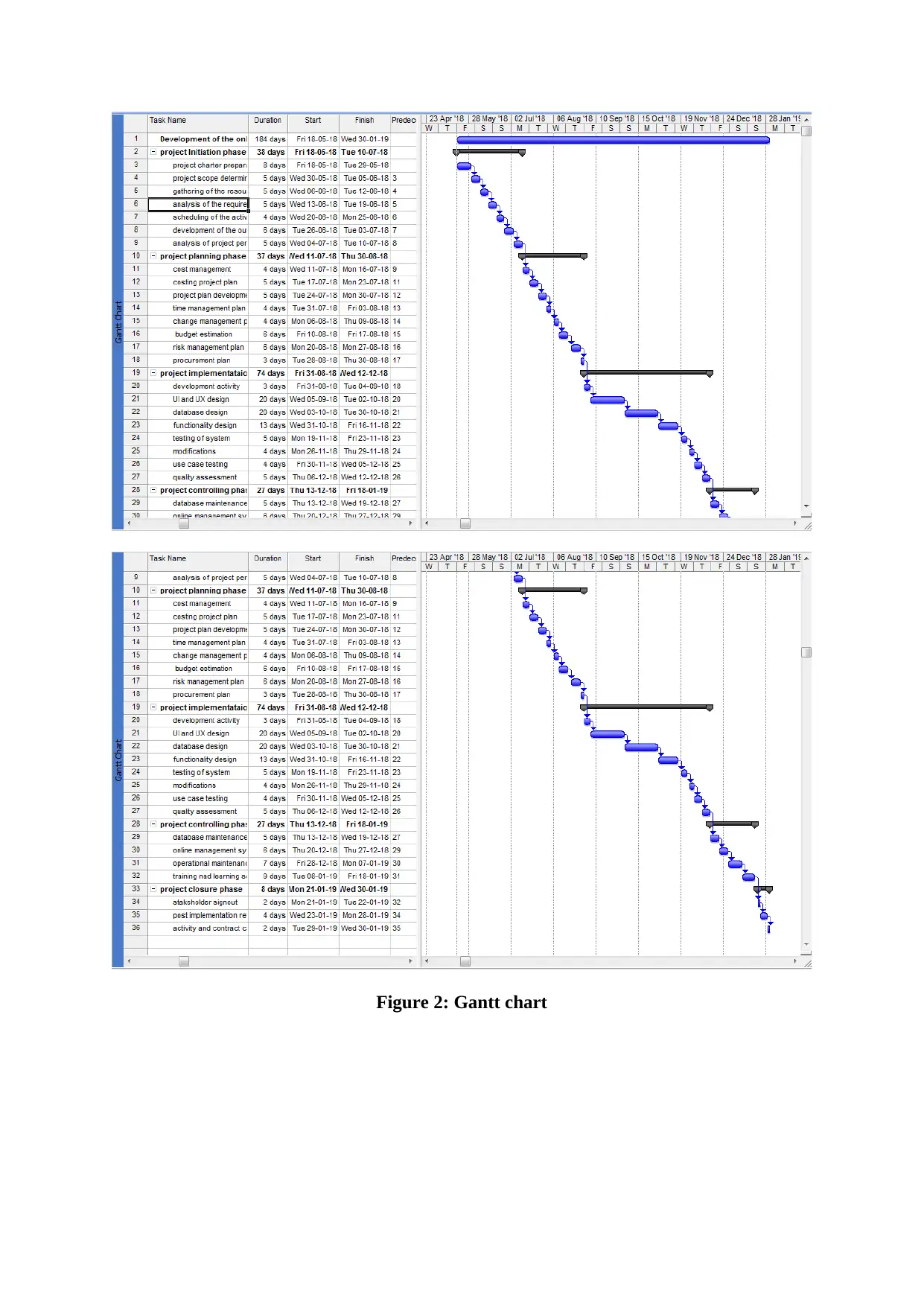
Figure 2: Gantt chart
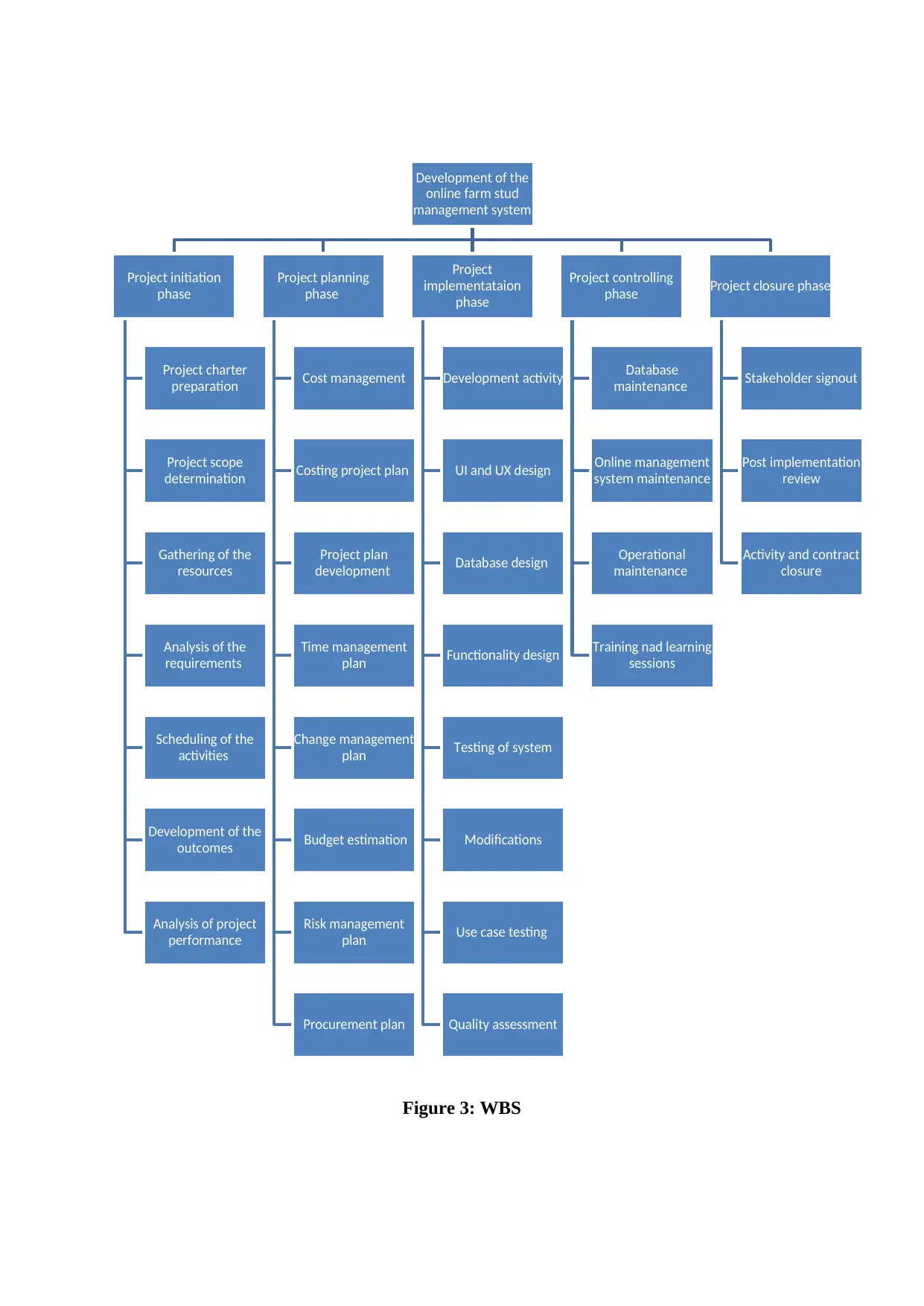
Figure 3: WBS
Development of the
online farm stud
management system
Project initiation
phase
Project charter
preparation
Project scope
determination
Gathering of the
resources
Analysis of the
requirements
Scheduling of the
activities
Development of the
outcomes
Analysis of project
performance
Project planning
phase
Cost management
Costing project plan
Project plan
development
Time management
plan
Change management
plan
Budget estimation
Risk management
plan
Procurement plan
Project
implementataion
phase
Development activity
UI and UX design
Database design
Functionality design
Testing of system
Modifications
Use case testing
Quality assessment
Project controlling
phase
Database
maintenance
Online management
system maintenance
Operational
maintenance
Training nad learning
sessions
Project closure phase
Stakeholder signout
Post implementation
review
Activity and contract
closure
Development of the
online farm stud
management system
Project initiation
phase
Project charter
preparation
Project scope
determination
Gathering of the
resources
Analysis of the
requirements
Scheduling of the
activities
Development of the
outcomes
Analysis of project
performance
Project planning
phase
Cost management
Costing project plan
Project plan
development
Time management
plan
Change management
plan
Budget estimation
Risk management
plan
Procurement plan
Project
implementataion
phase
Development activity
UI and UX design
Database design
Functionality design
Testing of system
Modifications
Use case testing
Quality assessment
Project controlling
phase
Database
maintenance
Online management
system maintenance
Operational
maintenance
Training nad learning
sessions
Project closure phase
Stakeholder signout
Post implementation
review
Activity and contract
closure
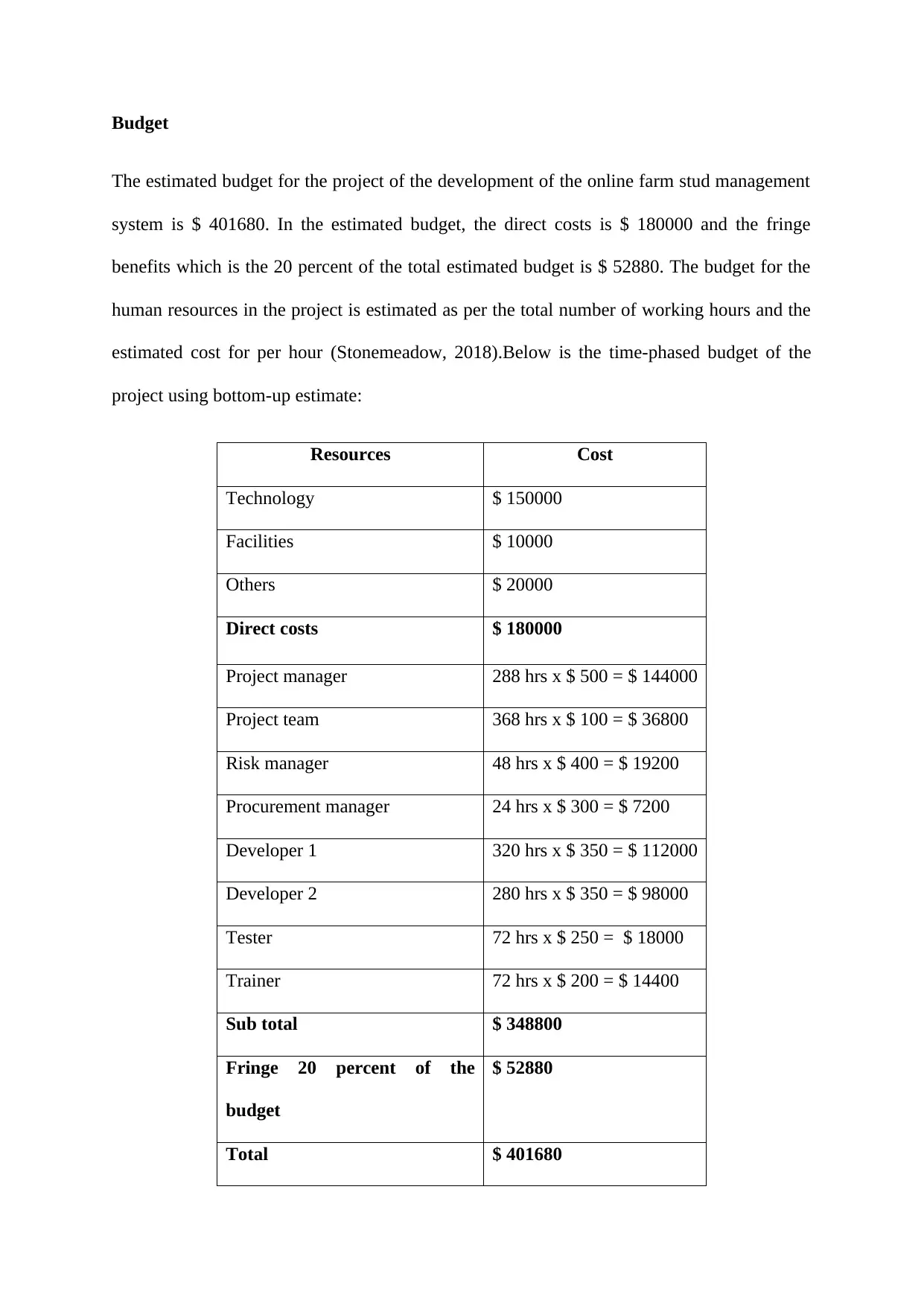
Budget
The estimated budget for the project of the development of the online farm stud management
system is $ 401680. In the estimated budget, the direct costs is $ 180000 and the fringe
benefits which is the 20 percent of the total estimated budget is $ 52880. The budget for the
human resources in the project is estimated as per the total number of working hours and the
estimated cost for per hour (Stonemeadow, 2018).Below is the time-phased budget of the
project using bottom-up estimate:
Resources Cost
Technology $ 150000
Facilities $ 10000
Others $ 20000
Direct costs $ 180000
Project manager 288 hrs x $ 500 = $ 144000
Project team 368 hrs x $ 100 = $ 36800
Risk manager 48 hrs x $ 400 = $ 19200
Procurement manager 24 hrs x $ 300 = $ 7200
Developer 1 320 hrs x $ 350 = $ 112000
Developer 2 280 hrs x $ 350 = $ 98000
Tester 72 hrs x $ 250 = $ 18000
Trainer 72 hrs x $ 200 = $ 14400
Sub total $ 348800
Fringe 20 percent of the
budget
$ 52880
Total $ 401680
The estimated budget for the project of the development of the online farm stud management
system is $ 401680. In the estimated budget, the direct costs is $ 180000 and the fringe
benefits which is the 20 percent of the total estimated budget is $ 52880. The budget for the
human resources in the project is estimated as per the total number of working hours and the
estimated cost for per hour (Stonemeadow, 2018).Below is the time-phased budget of the
project using bottom-up estimate:
Resources Cost
Technology $ 150000
Facilities $ 10000
Others $ 20000
Direct costs $ 180000
Project manager 288 hrs x $ 500 = $ 144000
Project team 368 hrs x $ 100 = $ 36800
Risk manager 48 hrs x $ 400 = $ 19200
Procurement manager 24 hrs x $ 300 = $ 7200
Developer 1 320 hrs x $ 350 = $ 112000
Developer 2 280 hrs x $ 350 = $ 98000
Tester 72 hrs x $ 250 = $ 18000
Trainer 72 hrs x $ 200 = $ 14400
Sub total $ 348800
Fringe 20 percent of the
budget
$ 52880
Total $ 401680
Secure Best Marks with AI Grader
Need help grading? Try our AI Grader for instant feedback on your assignments.
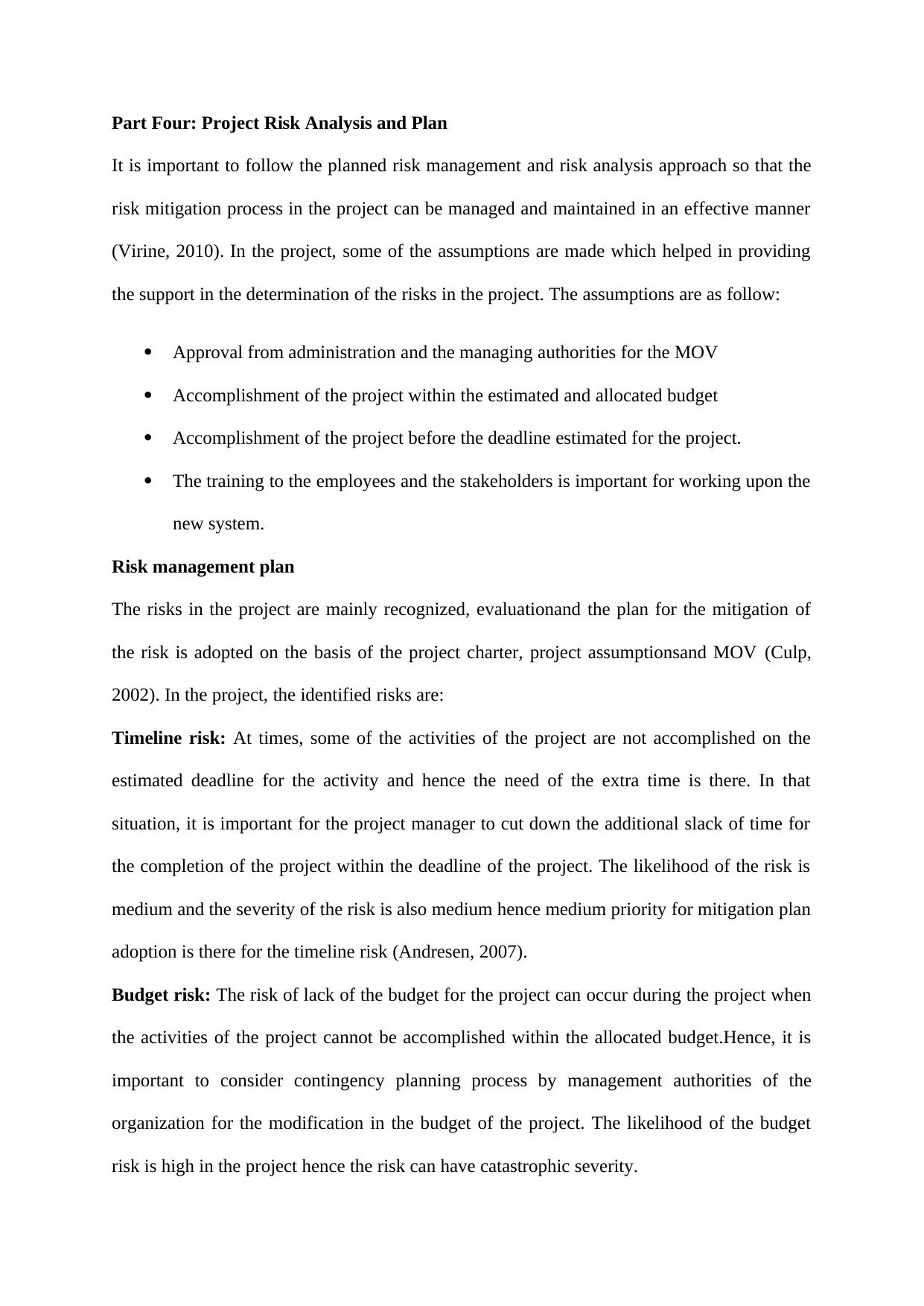
Part Four: Project Risk Analysis and Plan
It is important to follow the planned risk management and risk analysis approach so that the
risk mitigation process in the project can be managed and maintained in an effective manner
(Virine, 2010). In the project, some of the assumptions are made which helped in providing
the support in the determination of the risks in the project. The assumptions are as follow:
Approval from administration and the managing authorities for the MOV
Accomplishment of the project within the estimated and allocated budget
Accomplishment of the project before the deadline estimated for the project.
The training to the employees and the stakeholders is important for working upon the
new system.
Risk management plan
The risks in the project are mainly recognized, evaluationand the plan for the mitigation of
the risk is adopted on the basis of the project charter, project assumptionsand MOV (Culp,
2002). In the project, the identified risks are:
Timeline risk: At times, some of the activities of the project are not accomplished on the
estimated deadline for the activity and hence the need of the extra time is there. In that
situation, it is important for the project manager to cut down the additional slack of time for
the completion of the project within the deadline of the project. The likelihood of the risk is
medium and the severity of the risk is also medium hence medium priority for mitigation plan
adoption is there for the timeline risk (Andresen, 2007).
Budget risk: The risk of lack of the budget for the project can occur during the project when
the activities of the project cannot be accomplished within the allocated budget.Hence, it is
important to consider contingency planning process by management authorities of the
organization for the modification in the budget of the project. The likelihood of the budget
risk is high in the project hence the risk can have catastrophic severity.
It is important to follow the planned risk management and risk analysis approach so that the
risk mitigation process in the project can be managed and maintained in an effective manner
(Virine, 2010). In the project, some of the assumptions are made which helped in providing
the support in the determination of the risks in the project. The assumptions are as follow:
Approval from administration and the managing authorities for the MOV
Accomplishment of the project within the estimated and allocated budget
Accomplishment of the project before the deadline estimated for the project.
The training to the employees and the stakeholders is important for working upon the
new system.
Risk management plan
The risks in the project are mainly recognized, evaluationand the plan for the mitigation of
the risk is adopted on the basis of the project charter, project assumptionsand MOV (Culp,
2002). In the project, the identified risks are:
Timeline risk: At times, some of the activities of the project are not accomplished on the
estimated deadline for the activity and hence the need of the extra time is there. In that
situation, it is important for the project manager to cut down the additional slack of time for
the completion of the project within the deadline of the project. The likelihood of the risk is
medium and the severity of the risk is also medium hence medium priority for mitigation plan
adoption is there for the timeline risk (Andresen, 2007).
Budget risk: The risk of lack of the budget for the project can occur during the project when
the activities of the project cannot be accomplished within the allocated budget.Hence, it is
important to consider contingency planning process by management authorities of the
organization for the modification in the budget of the project. The likelihood of the budget
risk is high in the project hence the risk can have catastrophic severity.
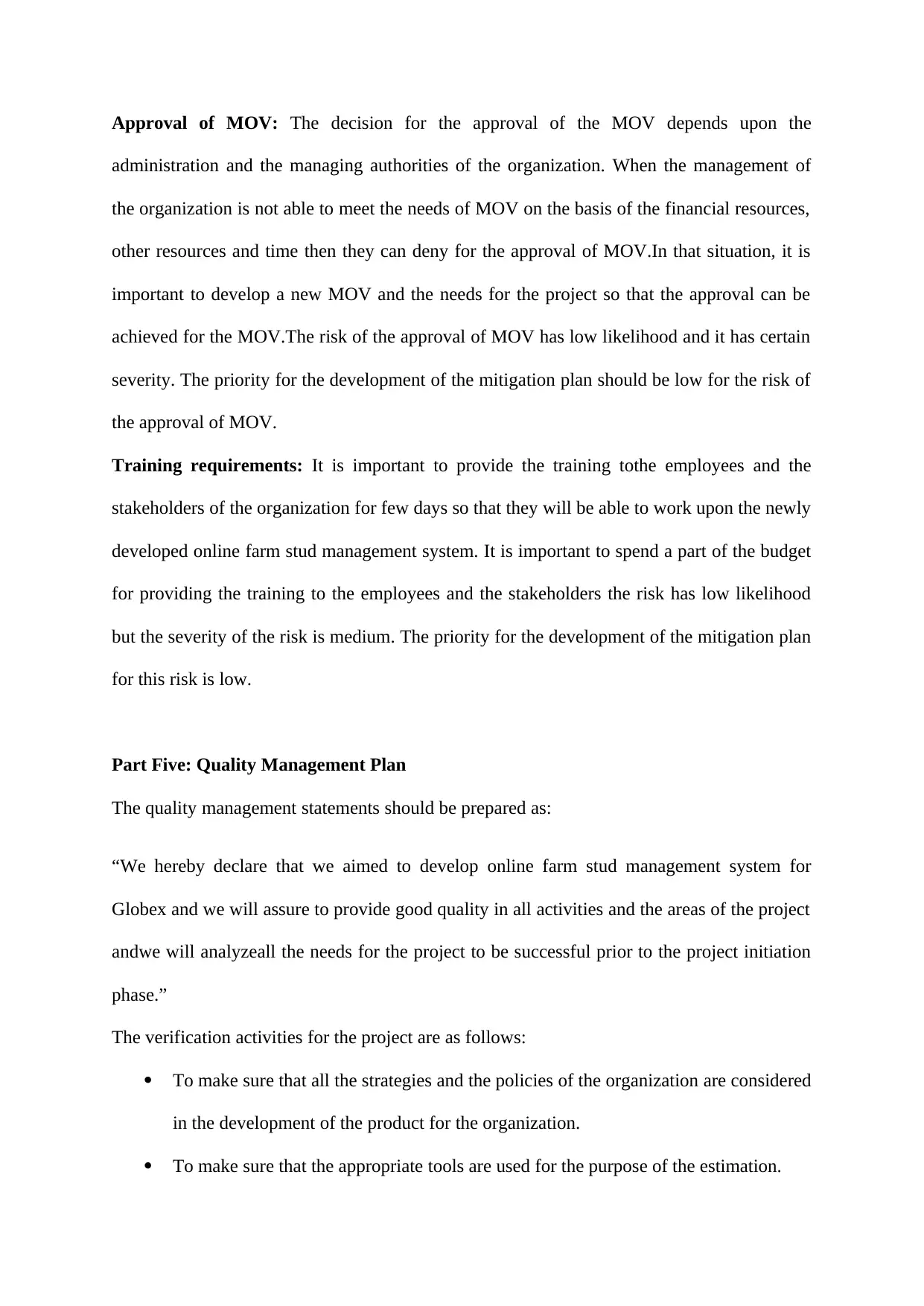
Approval of MOV: The decision for the approval of the MOV depends upon the
administration and the managing authorities of the organization. When the management of
the organization is not able to meet the needs of MOV on the basis of the financial resources,
other resources and time then they can deny for the approval of MOV.In that situation, it is
important to develop a new MOV and the needs for the project so that the approval can be
achieved for the MOV.The risk of the approval of MOV has low likelihood and it has certain
severity. The priority for the development of the mitigation plan should be low for the risk of
the approval of MOV.
Training requirements: It is important to provide the training tothe employees and the
stakeholders of the organization for few days so that they will be able to work upon the newly
developed online farm stud management system. It is important to spend a part of the budget
for providing the training to the employees and the stakeholders the risk has low likelihood
but the severity of the risk is medium. The priority for the development of the mitigation plan
for this risk is low.
Part Five: Quality Management Plan
The quality management statements should be prepared as:
“We hereby declare that we aimed to develop online farm stud management system for
Globex and we will assure to provide good quality in all activities and the areas of the project
andwe will analyzeall the needs for the project to be successful prior to the project initiation
phase.”
The verification activities for the project are as follows:
To make sure that all the strategies and the policies of the organization are considered
in the development of the product for the organization.
To make sure that the appropriate tools are used for the purpose of the estimation.
administration and the managing authorities of the organization. When the management of
the organization is not able to meet the needs of MOV on the basis of the financial resources,
other resources and time then they can deny for the approval of MOV.In that situation, it is
important to develop a new MOV and the needs for the project so that the approval can be
achieved for the MOV.The risk of the approval of MOV has low likelihood and it has certain
severity. The priority for the development of the mitigation plan should be low for the risk of
the approval of MOV.
Training requirements: It is important to provide the training tothe employees and the
stakeholders of the organization for few days so that they will be able to work upon the newly
developed online farm stud management system. It is important to spend a part of the budget
for providing the training to the employees and the stakeholders the risk has low likelihood
but the severity of the risk is medium. The priority for the development of the mitigation plan
for this risk is low.
Part Five: Quality Management Plan
The quality management statements should be prepared as:
“We hereby declare that we aimed to develop online farm stud management system for
Globex and we will assure to provide good quality in all activities and the areas of the project
andwe will analyzeall the needs for the project to be successful prior to the project initiation
phase.”
The verification activities for the project are as follows:
To make sure that all the strategies and the policies of the organization are considered
in the development of the product for the organization.
To make sure that the appropriate tools are used for the purpose of the estimation.
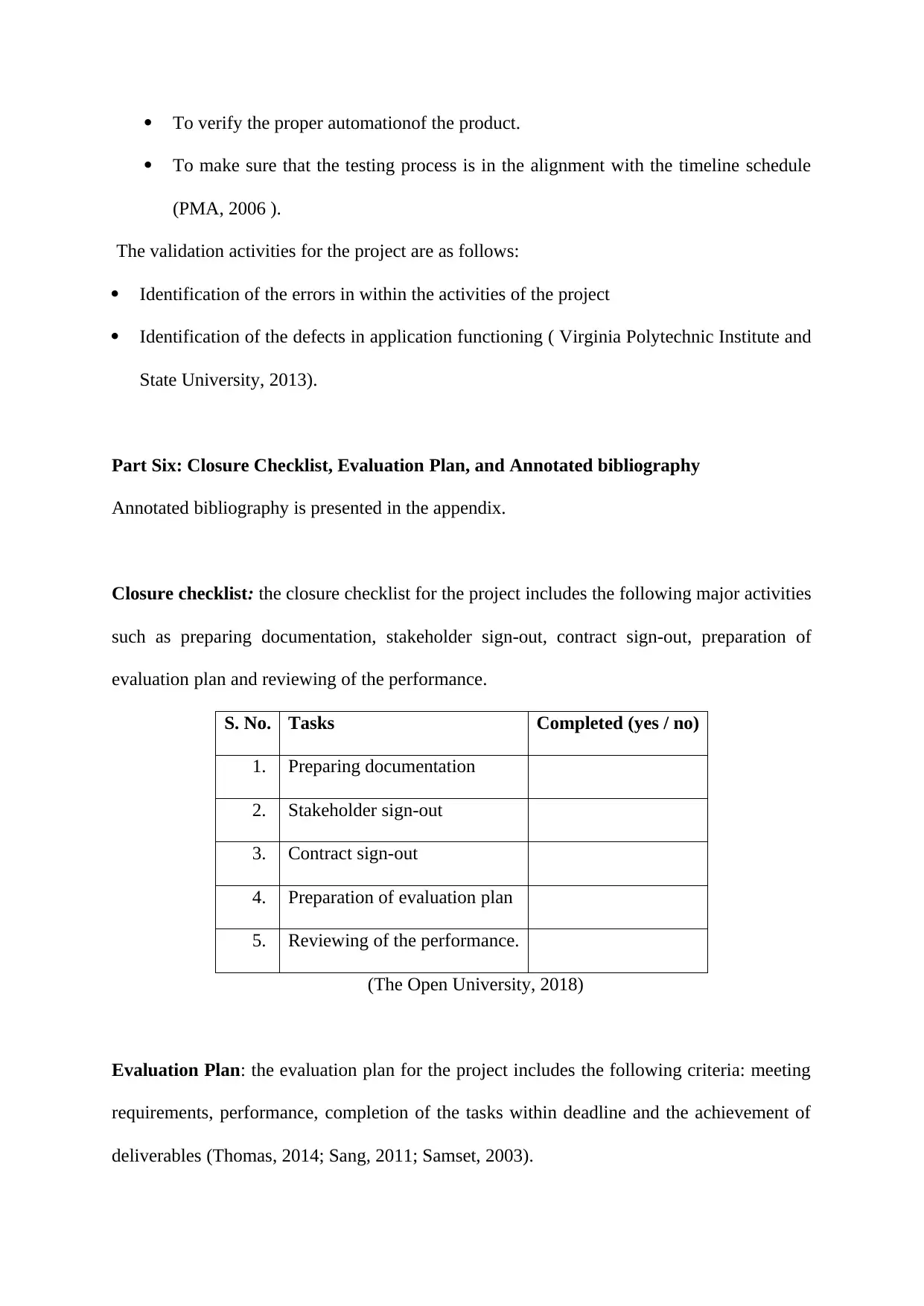
To verify the proper automationof the product.
To make sure that the testing process is in the alignment with the timeline schedule
(PMA, 2006 ).
The validation activities for the project are as follows:
Identification of the errors in within the activities of the project
Identification of the defects in application functioning ( Virginia Polytechnic Institute and
State University, 2013).
Part Six: Closure Checklist, Evaluation Plan, and Annotated bibliography
Annotated bibliography is presented in the appendix.
Closure checklist: the closure checklist for the project includes the following major activities
such as preparing documentation, stakeholder sign-out, contract sign-out, preparation of
evaluation plan and reviewing of the performance.
S. No. Tasks Completed (yes / no)
1. Preparing documentation
2. Stakeholder sign-out
3. Contract sign-out
4. Preparation of evaluation plan
5. Reviewing of the performance.
(The Open University, 2018)
Evaluation Plan: the evaluation plan for the project includes the following criteria: meeting
requirements, performance, completion of the tasks within deadline and the achievement of
deliverables (Thomas, 2014; Sang, 2011; Samset, 2003).
To make sure that the testing process is in the alignment with the timeline schedule
(PMA, 2006 ).
The validation activities for the project are as follows:
Identification of the errors in within the activities of the project
Identification of the defects in application functioning ( Virginia Polytechnic Institute and
State University, 2013).
Part Six: Closure Checklist, Evaluation Plan, and Annotated bibliography
Annotated bibliography is presented in the appendix.
Closure checklist: the closure checklist for the project includes the following major activities
such as preparing documentation, stakeholder sign-out, contract sign-out, preparation of
evaluation plan and reviewing of the performance.
S. No. Tasks Completed (yes / no)
1. Preparing documentation
2. Stakeholder sign-out
3. Contract sign-out
4. Preparation of evaluation plan
5. Reviewing of the performance.
(The Open University, 2018)
Evaluation Plan: the evaluation plan for the project includes the following criteria: meeting
requirements, performance, completion of the tasks within deadline and the achievement of
deliverables (Thomas, 2014; Sang, 2011; Samset, 2003).
Paraphrase This Document
Need a fresh take? Get an instant paraphrase of this document with our AI Paraphraser
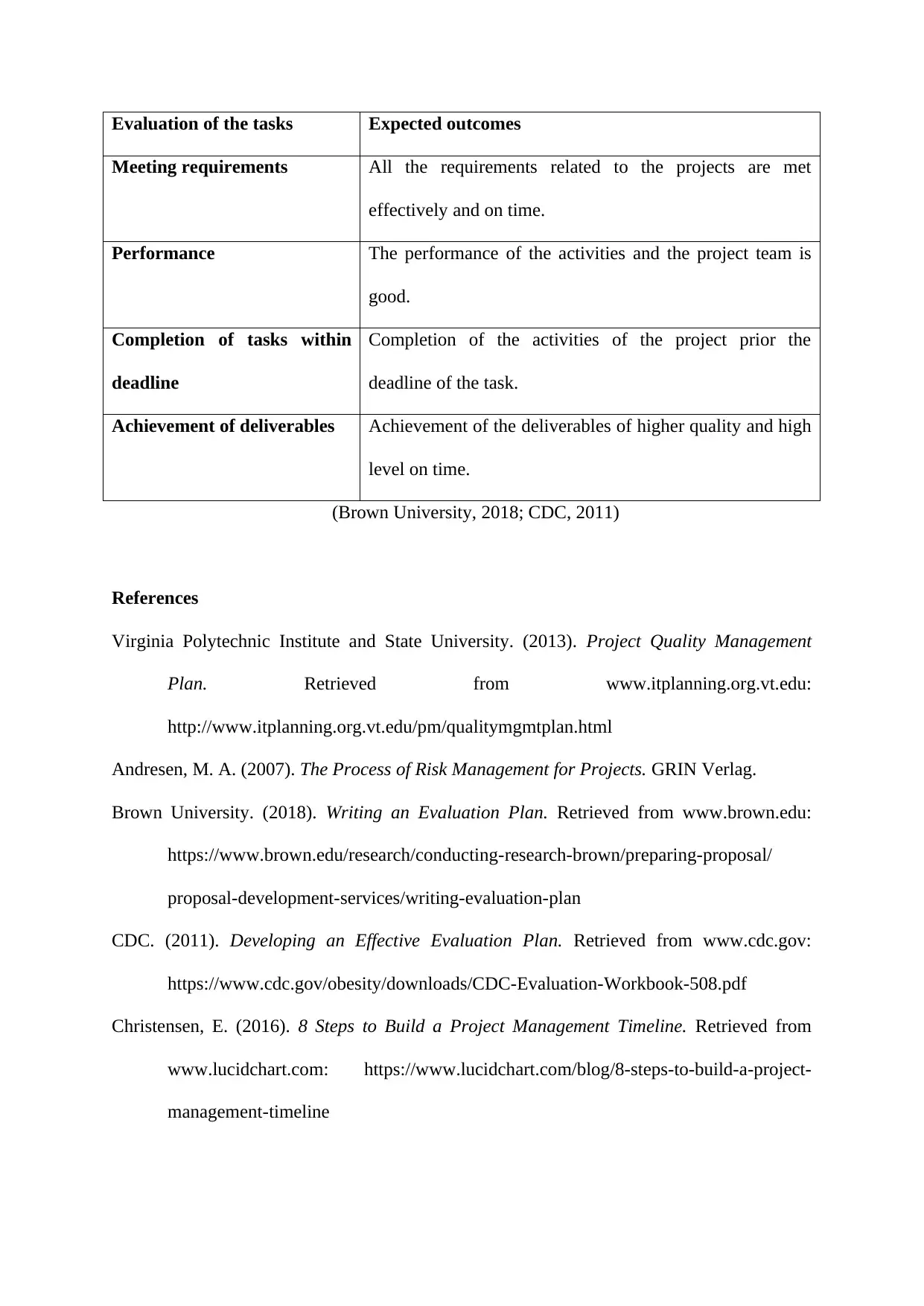
Evaluation of the tasks Expected outcomes
Meeting requirements All the requirements related to the projects are met
effectively and on time.
Performance The performance of the activities and the project team is
good.
Completion of tasks within
deadline
Completion of the activities of the project prior the
deadline of the task.
Achievement of deliverables Achievement of the deliverables of higher quality and high
level on time.
(Brown University, 2018; CDC, 2011)
References
Virginia Polytechnic Institute and State University. (2013). Project Quality Management
Plan. Retrieved from www.itplanning.org.vt.edu:
http://www.itplanning.org.vt.edu/pm/qualitymgmtplan.html
Andresen, M. A. (2007). The Process of Risk Management for Projects. GRIN Verlag.
Brown University. (2018). Writing an Evaluation Plan. Retrieved from www.brown.edu:
https://www.brown.edu/research/conducting-research-brown/preparing-proposal/
proposal-development-services/writing-evaluation-plan
CDC. (2011). Developing an Effective Evaluation Plan. Retrieved from www.cdc.gov:
https://www.cdc.gov/obesity/downloads/CDC-Evaluation-Workbook-508.pdf
Christensen, E. (2016). 8 Steps to Build a Project Management Timeline. Retrieved from
www.lucidchart.com: https://www.lucidchart.com/blog/8-steps-to-build-a-project-
management-timeline
Meeting requirements All the requirements related to the projects are met
effectively and on time.
Performance The performance of the activities and the project team is
good.
Completion of tasks within
deadline
Completion of the activities of the project prior the
deadline of the task.
Achievement of deliverables Achievement of the deliverables of higher quality and high
level on time.
(Brown University, 2018; CDC, 2011)
References
Virginia Polytechnic Institute and State University. (2013). Project Quality Management
Plan. Retrieved from www.itplanning.org.vt.edu:
http://www.itplanning.org.vt.edu/pm/qualitymgmtplan.html
Andresen, M. A. (2007). The Process of Risk Management for Projects. GRIN Verlag.
Brown University. (2018). Writing an Evaluation Plan. Retrieved from www.brown.edu:
https://www.brown.edu/research/conducting-research-brown/preparing-proposal/
proposal-development-services/writing-evaluation-plan
CDC. (2011). Developing an Effective Evaluation Plan. Retrieved from www.cdc.gov:
https://www.cdc.gov/obesity/downloads/CDC-Evaluation-Workbook-508.pdf
Christensen, E. (2016). 8 Steps to Build a Project Management Timeline. Retrieved from
www.lucidchart.com: https://www.lucidchart.com/blog/8-steps-to-build-a-project-
management-timeline

Culp, C. L. (2002). The Risk Management Process: Business Strategy and Tactics. John
Wiley & Sons.
Florida Distance Learning Consortium. (2018). Define Project Values. Retrieved from
www.oncoreblueprint.org:
http://www.oncoreblueprint.org/blueprint/phase_I_planning/strategic_planning/
conduct_planning_session/define_project_values.html
Lee, C. (2010). Metrics in Project Management . Retrieved from www.cprime.com:
https://www.cprime.com/2010/07/metrics-in-project-management/
Marchewka, J. T. (2014). Information Technology Project Management. (05th Edition ed.).
Singapore: 1STBL. Retrieved from https://sis.binus.ac.id/2018/02/09/measurable-
organizational-value-mov/
Monnappa, A. (2018). Project Scope Management: What It is and Why It’s Important.
Retrieved from www.simplilearn.com: https://www.simplilearn.com/project-scope-
management-importance-rar89-article
Nordmeyer, B. (2017). What Are Measurable Organizational Values? Retrieved from
bizfluent.com: https://bizfluent.com/info-8352967-measurable-organizational-
values.html
Persons, J. B., Davidson, J., & Tompkins, M. A. (2018). Activity Scheduling. Retrieved from
www.apa.org: http://www.apa.org/pubs/videos/4310748.aspx
PMA. ( 2006 ). Stage 3: Plan the Project. Retrieved from pma.doit.wisc.edu:
https://pma.doit.wisc.edu/plan/3-2/what.html
Samset, K. (2003). Project Evaluation: Making Investments Succeed . Tapir Academic.
Sang, H.-K. (2011). Project evaluation: techniques and practices for developing countries.
Avebury.
Wiley & Sons.
Florida Distance Learning Consortium. (2018). Define Project Values. Retrieved from
www.oncoreblueprint.org:
http://www.oncoreblueprint.org/blueprint/phase_I_planning/strategic_planning/
conduct_planning_session/define_project_values.html
Lee, C. (2010). Metrics in Project Management . Retrieved from www.cprime.com:
https://www.cprime.com/2010/07/metrics-in-project-management/
Marchewka, J. T. (2014). Information Technology Project Management. (05th Edition ed.).
Singapore: 1STBL. Retrieved from https://sis.binus.ac.id/2018/02/09/measurable-
organizational-value-mov/
Monnappa, A. (2018). Project Scope Management: What It is and Why It’s Important.
Retrieved from www.simplilearn.com: https://www.simplilearn.com/project-scope-
management-importance-rar89-article
Nordmeyer, B. (2017). What Are Measurable Organizational Values? Retrieved from
bizfluent.com: https://bizfluent.com/info-8352967-measurable-organizational-
values.html
Persons, J. B., Davidson, J., & Tompkins, M. A. (2018). Activity Scheduling. Retrieved from
www.apa.org: http://www.apa.org/pubs/videos/4310748.aspx
PMA. ( 2006 ). Stage 3: Plan the Project. Retrieved from pma.doit.wisc.edu:
https://pma.doit.wisc.edu/plan/3-2/what.html
Samset, K. (2003). Project Evaluation: Making Investments Succeed . Tapir Academic.
Sang, H.-K. (2011). Project evaluation: techniques and practices for developing countries.
Avebury.
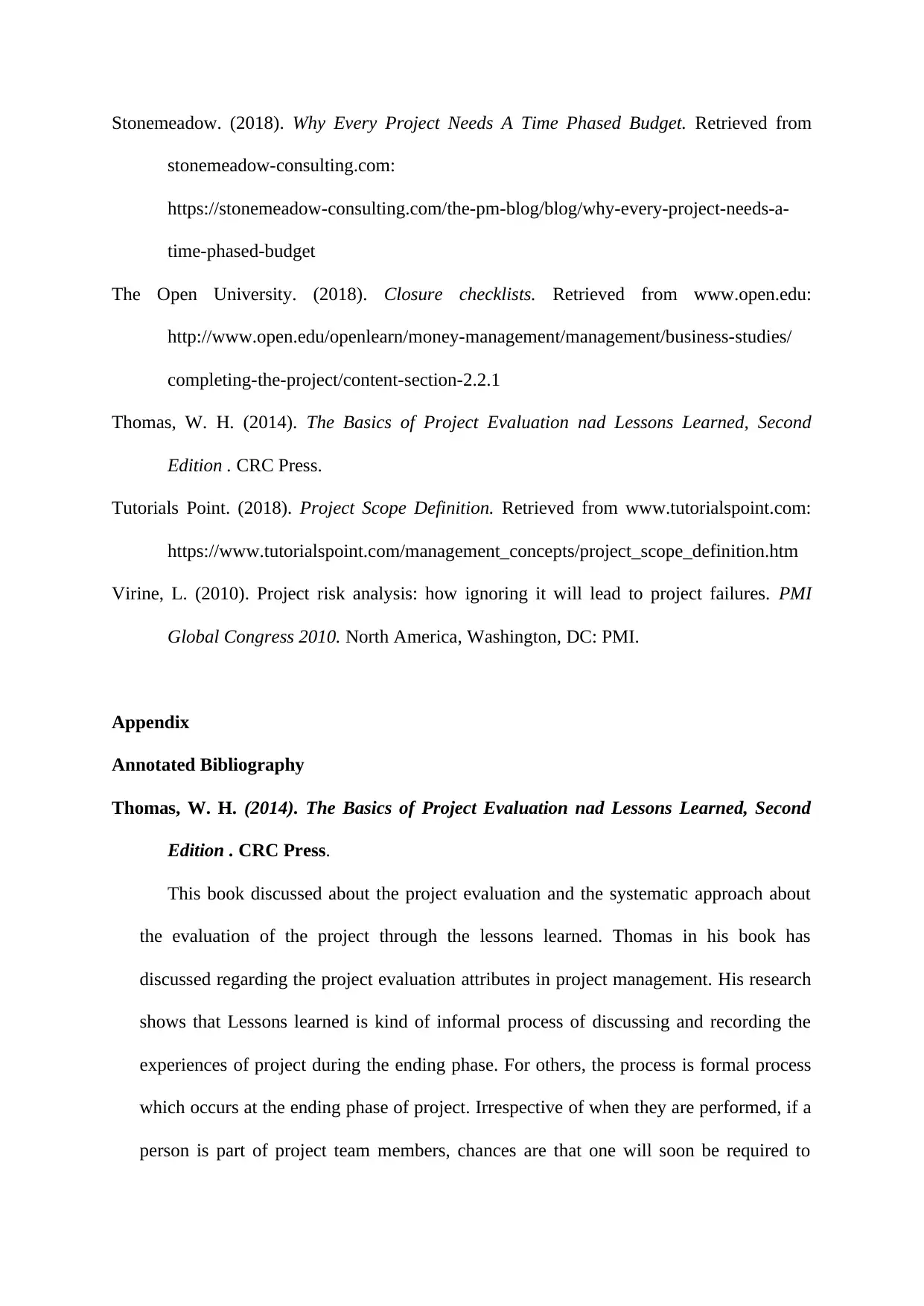
Stonemeadow. (2018). Why Every Project Needs A Time Phased Budget. Retrieved from
stonemeadow-consulting.com:
https://stonemeadow-consulting.com/the-pm-blog/blog/why-every-project-needs-a-
time-phased-budget
The Open University. (2018). Closure checklists. Retrieved from www.open.edu:
http://www.open.edu/openlearn/money-management/management/business-studies/
completing-the-project/content-section-2.2.1
Thomas, W. H. (2014). The Basics of Project Evaluation nad Lessons Learned, Second
Edition . CRC Press.
Tutorials Point. (2018). Project Scope Definition. Retrieved from www.tutorialspoint.com:
https://www.tutorialspoint.com/management_concepts/project_scope_definition.htm
Virine, L. (2010). Project risk analysis: how ignoring it will lead to project failures. PMI
Global Congress 2010. North America, Washington, DC: PMI.
Appendix
Annotated Bibliography
Thomas, W. H. (2014). The Basics of Project Evaluation nad Lessons Learned, Second
Edition . CRC Press.
This book discussed about the project evaluation and the systematic approach about
the evaluation of the project through the lessons learned. Thomas in his book has
discussed regarding the project evaluation attributes in project management. His research
shows that Lessons learned is kind of informal process of discussing and recording the
experiences of project during the ending phase. For others, the process is formal process
which occurs at the ending phase of project. Irrespective of when they are performed, if a
person is part of project team members, chances are that one will soon be required to
stonemeadow-consulting.com:
https://stonemeadow-consulting.com/the-pm-blog/blog/why-every-project-needs-a-
time-phased-budget
The Open University. (2018). Closure checklists. Retrieved from www.open.edu:
http://www.open.edu/openlearn/money-management/management/business-studies/
completing-the-project/content-section-2.2.1
Thomas, W. H. (2014). The Basics of Project Evaluation nad Lessons Learned, Second
Edition . CRC Press.
Tutorials Point. (2018). Project Scope Definition. Retrieved from www.tutorialspoint.com:
https://www.tutorialspoint.com/management_concepts/project_scope_definition.htm
Virine, L. (2010). Project risk analysis: how ignoring it will lead to project failures. PMI
Global Congress 2010. North America, Washington, DC: PMI.
Appendix
Annotated Bibliography
Thomas, W. H. (2014). The Basics of Project Evaluation nad Lessons Learned, Second
Edition . CRC Press.
This book discussed about the project evaluation and the systematic approach about
the evaluation of the project through the lessons learned. Thomas in his book has
discussed regarding the project evaluation attributes in project management. His research
shows that Lessons learned is kind of informal process of discussing and recording the
experiences of project during the ending phase. For others, the process is formal process
which occurs at the ending phase of project. Irrespective of when they are performed, if a
person is part of project team members, chances are that one will soon be required to
Secure Best Marks with AI Grader
Need help grading? Try our AI Grader for instant feedback on your assignments.
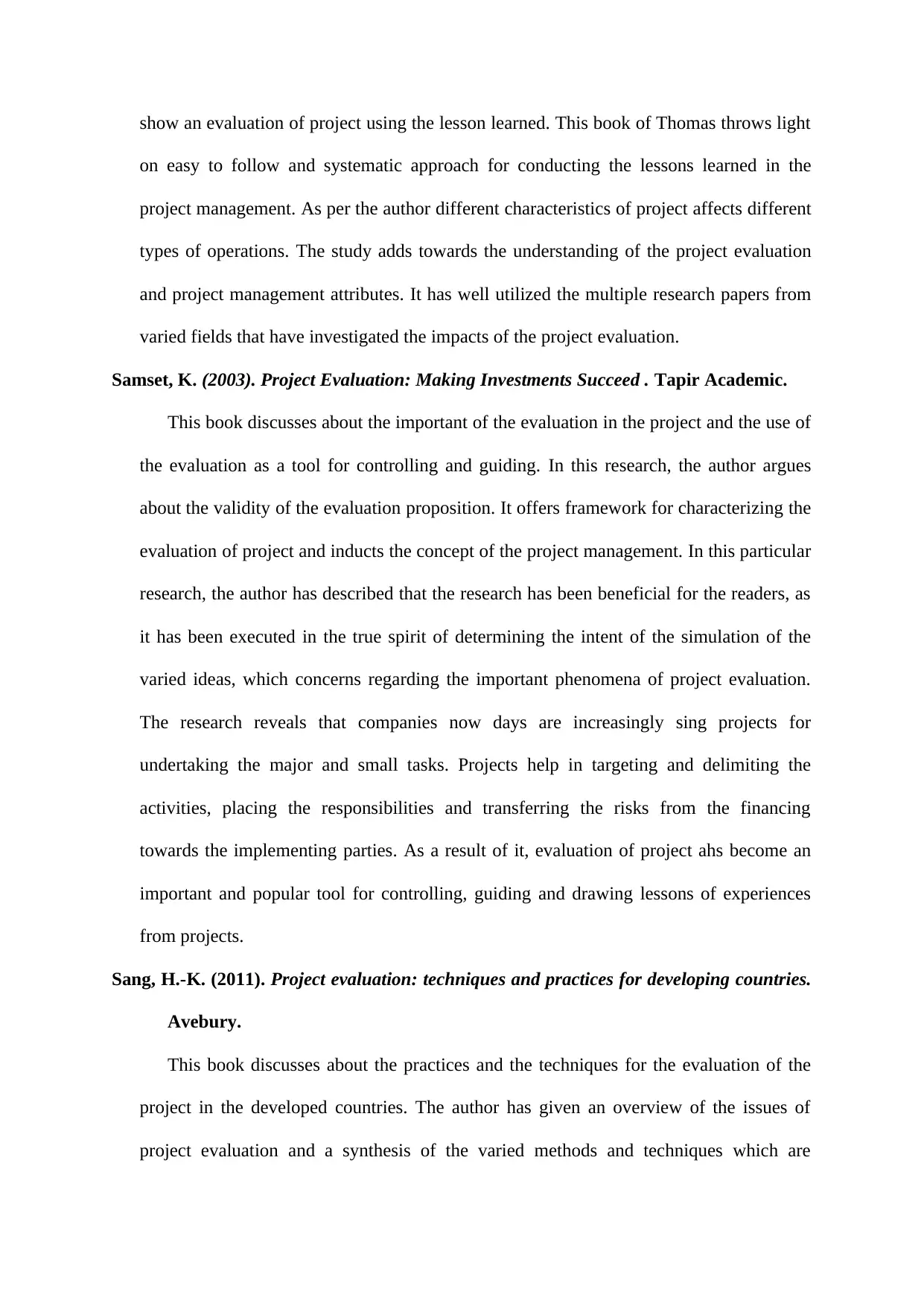
show an evaluation of project using the lesson learned. This book of Thomas throws light
on easy to follow and systematic approach for conducting the lessons learned in the
project management. As per the author different characteristics of project affects different
types of operations. The study adds towards the understanding of the project evaluation
and project management attributes. It has well utilized the multiple research papers from
varied fields that have investigated the impacts of the project evaluation.
Samset, K. (2003). Project Evaluation: Making Investments Succeed . Tapir Academic.
This book discusses about the important of the evaluation in the project and the use of
the evaluation as a tool for controlling and guiding. In this research, the author argues
about the validity of the evaluation proposition. It offers framework for characterizing the
evaluation of project and inducts the concept of the project management. In this particular
research, the author has described that the research has been beneficial for the readers, as
it has been executed in the true spirit of determining the intent of the simulation of the
varied ideas, which concerns regarding the important phenomena of project evaluation.
The research reveals that companies now days are increasingly sing projects for
undertaking the major and small tasks. Projects help in targeting and delimiting the
activities, placing the responsibilities and transferring the risks from the financing
towards the implementing parties. As a result of it, evaluation of project ahs become an
important and popular tool for controlling, guiding and drawing lessons of experiences
from projects.
Sang, H.-K. (2011). Project evaluation: techniques and practices for developing countries.
Avebury.
This book discusses about the practices and the techniques for the evaluation of the
project in the developed countries. The author has given an overview of the issues of
project evaluation and a synthesis of the varied methods and techniques which are
on easy to follow and systematic approach for conducting the lessons learned in the
project management. As per the author different characteristics of project affects different
types of operations. The study adds towards the understanding of the project evaluation
and project management attributes. It has well utilized the multiple research papers from
varied fields that have investigated the impacts of the project evaluation.
Samset, K. (2003). Project Evaluation: Making Investments Succeed . Tapir Academic.
This book discusses about the important of the evaluation in the project and the use of
the evaluation as a tool for controlling and guiding. In this research, the author argues
about the validity of the evaluation proposition. It offers framework for characterizing the
evaluation of project and inducts the concept of the project management. In this particular
research, the author has described that the research has been beneficial for the readers, as
it has been executed in the true spirit of determining the intent of the simulation of the
varied ideas, which concerns regarding the important phenomena of project evaluation.
The research reveals that companies now days are increasingly sing projects for
undertaking the major and small tasks. Projects help in targeting and delimiting the
activities, placing the responsibilities and transferring the risks from the financing
towards the implementing parties. As a result of it, evaluation of project ahs become an
important and popular tool for controlling, guiding and drawing lessons of experiences
from projects.
Sang, H.-K. (2011). Project evaluation: techniques and practices for developing countries.
Avebury.
This book discusses about the practices and the techniques for the evaluation of the
project in the developed countries. The author has given an overview of the issues of
project evaluation and a synthesis of the varied methods and techniques which are
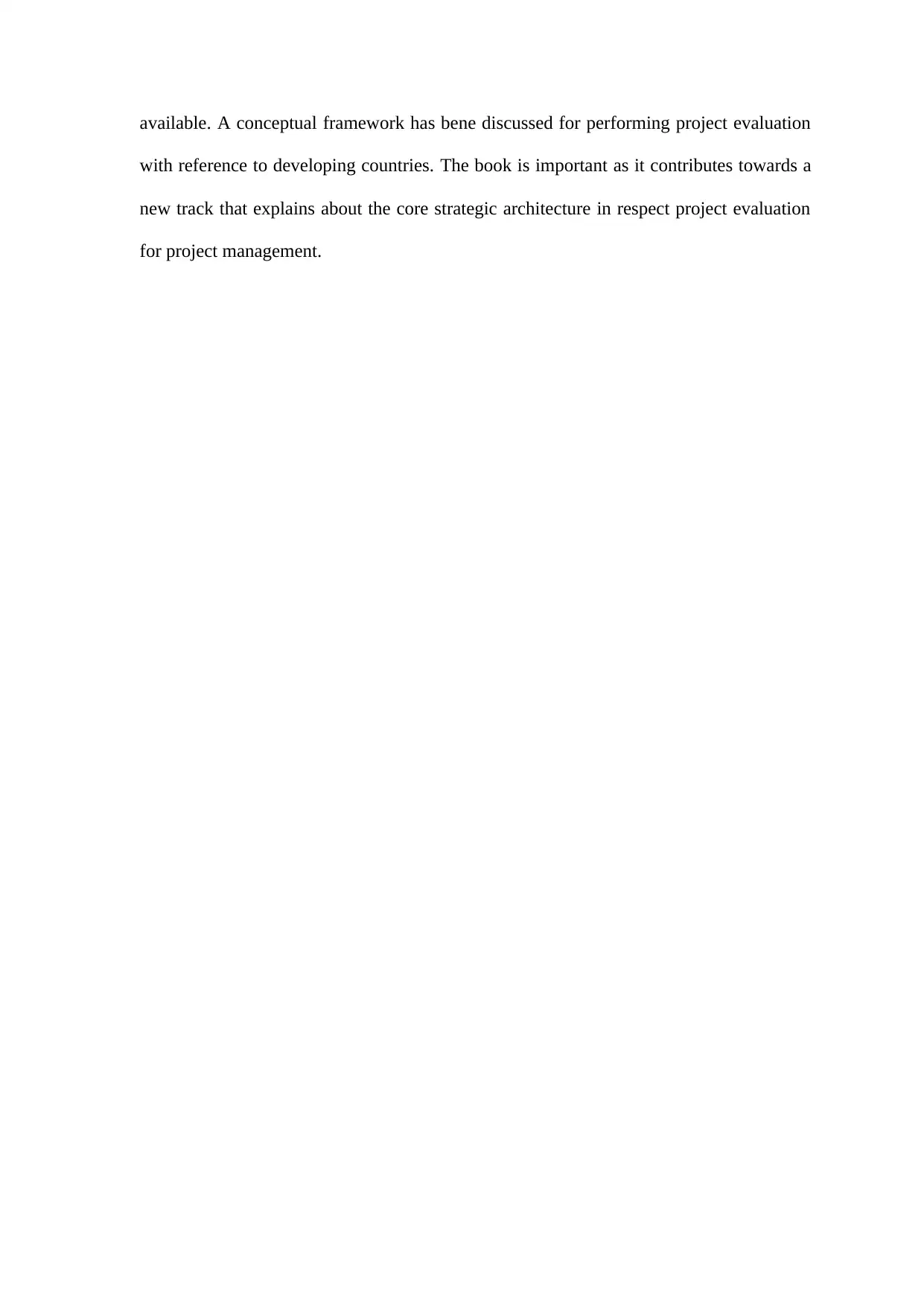
available. A conceptual framework has bene discussed for performing project evaluation
with reference to developing countries. The book is important as it contributes towards a
new track that explains about the core strategic architecture in respect project evaluation
for project management.
with reference to developing countries. The book is important as it contributes towards a
new track that explains about the core strategic architecture in respect project evaluation
for project management.
1 out of 18
Related Documents
Your All-in-One AI-Powered Toolkit for Academic Success.
+13062052269
info@desklib.com
Available 24*7 on WhatsApp / Email
![[object Object]](/_next/static/media/star-bottom.7253800d.svg)
Unlock your academic potential
© 2024 | Zucol Services PVT LTD | All rights reserved.





